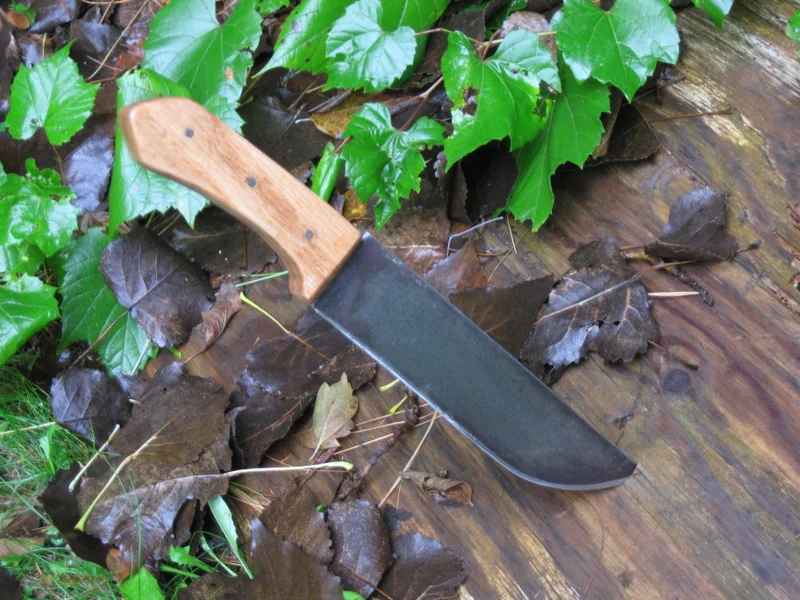Humans have needed knives for aeons. They have different shapes, sizes, and purposes. The tang is a knife’s unseen yet vital part. This guide covers knife tangs, their types, importance, and more. Let’s explore the tang’s secrets!
What is a Tang on a Knife?
The knife blade’s tang extends into the handle. It joins the blade and handle, assuring the knife’s stability and durability. Simply said, the tang supports the knife internally, preventing fractures and ensuring balance.
Why is the Tang Important?
Knife performance and durability depend on the tang. Tang importance:
Stability: The tang gives the knife strength. It links the blade and handle. A solid tang keeps the knife strong throughout cutting and slicing. Pressure can break or bend a knife without a robust tang.
Prevents Handle Separation: The tang keeps the blade and handle together. It keeps the handle from detaching from the blade, preventing accidents and maintaining user safety. A durable tang construction keeps the knife intact and usable under tough conditions.
Enhanced Control and Balance: The tang improves knife balance and control. Full tang designs distribute blade and handle weight better. This balance improves cutting manoeuvrability and precision, improving accuracy and efficiency.
Longevity and Durability: Solid-tang knives endure longer. The knife’s tang distributes pressure to prevent localised stress. The knife is less likely to shatter or detach. A strong tang makes a knife durable.
Versatility and adaptability: A strong-tang knife can be used for many purposes. A solid tang knife can cut, slice, and chop in culinary prep, outdoor activities, and survival scenarios. Tang strength and stability make the knife versatile.
Different Types of Tangs

Full Tang
The blade extends through the handle in a complete tang. The tang is evident throughout the handle. This tang gives the knife optimal strength and stability. Full-tang knives are known for their strength and longevity. Pins or screws secure the handle to the tang.
Partial Tang
As the name implies, a partial tang does not cover the full handle. It halfway enters the handle. In aesthetic knives, the handle material layers or covers the tang.
Partial tang knives are less sturdy and ideal for lesser applications than full tang blades. Not all partial tang knives are bad, although they may not be as strong or reliable as full tang knives.
Rat-Tail Tang
Rat-tail tangs are narrower and taper towards the end, mimicking rat tails. This tang is found in cheap or low-quality knives because it lacks the strength and stability of full or partial tangs.
The rat-tail tang is commonly epoxy-glued into a hollow handle. Rat-tail tang knives are fragile and not suited for heavy-duty or continuous use.
Advantages of Full Tang Knives

Full-tang knives have various advantages over other tangs:
Strength and Durability: The full tang design makes the knife more resistant to breaking or bending. Full-tang knives are suitable for chopping, batoning, and survival circumstances where reliability is essential.
Better Balance: Full-tang knives are more balanced. Cutting and slicing are easier with a better balanced blade and handle.
Enhanced Safety: Full-tang knives’ strong structure increases safety. The handle is less prone to detach from the blade, decreasing accidents and injuries.
Versatility: Full-tang knives can be used in many ways. Full-tang knives are versatile for chefs, outdoorsmen, and hobbyists.
How to Identify the Tang Type?
A knife’s handle and blade reveal its tang type. Methods to detect tang type:
Visible Tang: A full-tang knife has a visible tang along the handle. Look for exposed pins or screws that hold the handle to the tang. This shows a full-tang knife.
Handle Construction: A partial tang or rat-tail tang knife’s handle covers the entire tang. The handle’s seams or joints may indicate the tang’s termination. A partial tang or rat-tail tang design is indicated by layered handles or gaps between the handle and blade.
Weight and Balance: Solid full-tang knives are heavier. Watch the knife’s weight and balance. A full-tang knife will be well-balanced and heavy. Partial or rat-tail tang knives may be lighter or less balanced.
Knife Tang FAQs
Why do knives have tangs?
A knife’s tang connects the blade and handle. It gives the knife structure, strength, and stability to resist diverse tasks. A knife without a tang would be weak and breakable.
Is a partial-tang knife as durable as a full-tang one?
Depending on manufacturing and application, partial tang knives can be durable. A good half tang knife can handle light jobs and occasional use. A full-tang knife is suggested for heavy-duty tasks or scenarios that require durability and strength.
Are rat-tail tang knives bad?
Rat-tail tang knives have some drawbacks. Rat-tail tangs break easily due to their small, tapered form. Adhesives can also loosen the handle from the rat-tail tang. Rat-tail tang knives are not recommended for heavy or prolonged use.
Is a knife full-tang?
The handle structure can reveal a complete tang knife. Look for blade-to-handle metal. Full-tang knives have pins, screws, or metal handles. Full-tang knives also feel more substantial and balanced.
What are some popular full-tang knife brands?
Full-tang knife brands are known for their quality. Wusthof, Victorinox, Zwilling J.A. Henckels, Benchmade, and Buck Knives. These brands are known for making high-quality full-tang knives.
Can I construct a full-tang knife?
Full-tang knives can be made. Knife crafting is fun since you can customise the design, materials, and construction. Knife-making instructions, books, and workshops are available. To make a knife safely, you need the right tools, knowledge, and safety procedures.
Conclusion
Finally, the tang gives a knife strength, stability, and durability. Understanding complete, partial, and rat-tail tangs helps you choose a knife for your purposes.
Full-tang knives are stronger and more balanced, but partial-tang and rat-tail-tang blades can still be useful. You can choose a reliable knife by studying the tang type. Next time you pick up a knife, appreciate the tang’s role in its performance.
